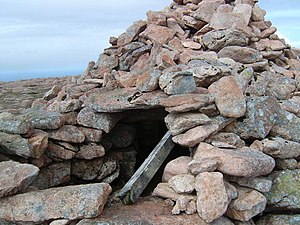Ronas Hill
| Ronas Hill | |||
| Shetland | |||
|---|---|---|---|
 Chambered cairn on the summit of Ronas Hill | |||
| Mainland, Shetland | |||
| Summit: | 1,476 feet HU305834 60°31’59"N, 1°26’46"W | ||
Ronas Hill (or Rönies Hill) provides the highest point of Shetland. The hill is on Mainland. The name of the hill is from Old Norse rön, meaning "stony ground" or "scree".
There is a Neolithic chambered cairn near the summit.
Geography
Ronas Hill is on the Northmavine peninsula of Mainland, Shetland. It rises to 1,476 feet, which makes it the highest point in all Shetland; the county top.
The Norse name "Stony Ground" is a good description of the hilltop.
On a clear day, much of Shetland can be seen from the summit. It looks over Yell Sound, the North Sea, across to the Atlantic Ocean[1] and even the highest points of Fair Isle.[1]
Wild plants
Ronas Hill is a Ramsar site,[2] containing many rare Arctic plants.[1] Peculiarly for Shetland, there are several species of woodland fungi, notably ceps and chanterelles, which normally grow on the roots of deciduous trees (notable by their absence on Ronas Hill). Here, they are associated with creeping willow, which grows extensively on the hill.
Chambered cairn
On top of the hill, there is a Neolithic chambered cairn,[3] unusual for its position on top of a hill. Most surviving Neolithic British cairns are sited in prominent places, but not generally on the top of taller hills. According to local farmers, until the construction of Sullom Voe Terminal in the mid-1970s, the cairn contained a variety of "sacrifice" items, such as coins (some "very old") and other items. Before that time, Ronas Hill would have been far off the beaten track.
Ronas Hill cairn shows evidence of substantial rebuilding of its upper structure, as evidenced by the lack of lichen on stones above the entry passage and main cyst. The current peak of pink granite stones is clearly visible from the valley below and may have been raised in height to serve as a "mede" or fishing mark in past centuries. The cairn was certainly altered by soldiers during a military exercise in the 1960s, when a wall was built around its entrance to turn it into a foxhole.
References
- ↑ 1.0 1.1 1.2 "North Mainland". Visit Scotland. http://www.visitshetland.com/area-guides/north-mainland/northmavine. Retrieved 26 April 2009.
- ↑ "Special Areas of Conservation (SAC)". JNCC. http://www.jncc.gov.uk/protectedsites/SACselection/SAC.asp?EUCode=UK0019797. Retrieved 26 April 2009.
- ↑ "Ronas Hill". Gazetteer for Scotland. http://www.scottish-places.info/features/featurefirst1414.html. Retrieved 26 April 2009.